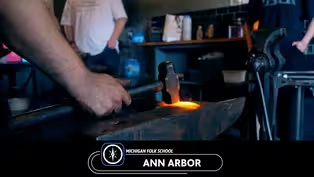Destination Michigan
History of Tee Ball
Clip: Season 16 Episode 4 | 7mVideo has Closed Captions
History of Tee Ball
Play Ball! Grab your peanuts and Cracker Jacks for a stop in Albion, where we’ll explore the origins of tee ball and of course, we don’t care if we ever get back!
Problems playing video? | Closed Captioning Feedback
Problems playing video? | Closed Captioning Feedback
Destination Michigan is a local public television program presented by WCMU
Destination Michigan
History of Tee Ball
Clip: Season 16 Episode 4 | 7mVideo has Closed Captions
Play Ball! Grab your peanuts and Cracker Jacks for a stop in Albion, where we’ll explore the origins of tee ball and of course, we don’t care if we ever get back!
Problems playing video? | Closed Captioning Feedback
How to Watch Destination Michigan
Destination Michigan is available to stream on pbs.org and the free PBS App, available on iPhone, Apple TV, Android TV, Android smartphones, Amazon Fire TV, Amazon Fire Tablet, Roku, Samsung Smart TV, and Vizio.
Providing Support for PBS.org
Learn Moreabout PBS online sponsorship(lively music) - It was small town America that invented T-ball.
As a retired history teacher and historian, it's always cool to go to the place where it happened and this is where it happened.
This is where it started.
It wasn't in a boardroom, it wasn't in some academic lab.
And you just kind of walk around and say the first T-ball players walked these streets, played on that field.
I think it gives kind of a visceral feeling that you can kind of immerse yourself into, "Okay, I get it.
It was just a little town in Michigan and they came up with this idea and everybody's copied it."
- [Chris] It may not be the room where it happened, but Albion, Michigan is most definitely the place that it happened.
But how did it happen?
- Jerry Sacharski, a city rec director who decided we need to do something with these kids that like baseball and give them an outlet.
During the timeframe of the development of T-ball, that was in the mid-1950s, and he worked for a guy named Arnold Spaan and Jerry Sacharski was the baseball commissioner or he ran the baseball program.
And so that's how he ends up deciding to create this T-ball for little kids.
- [Chris] T-ball is as American as apple pie and rock and roll.
And in the late 1950s, Jerry Sacharski put the ball on the tee and developed a game for aspiring kids with Big League dreams.
In July of 1960, Jerry explained the purpose of T-ball as he viewed it to Michigan State's Gus Ganakas.
- Most of you baseball fans probably know what a regulation baseball diamond looks like, but today's diamond might be less recognizable to you.
In fact, here with me is Jerry Sacharski, the director of the Albion Baseball Program.
And Jerry, I walked on the field and the only thing I recognized were the bases.
Could you tell us a little bit about what the layout looks like here and the rules by which these boys from Albion will be playing today?
- All right, I sure will, Gus.
First of all, let me state that peewee baseball is a playground game.
It's a playground activity.
We wanna make it clear that peewee baseball is primarily for participation and drill in the fundamentals of the game, the simple fundamentals, throwing, catching, running the bases and swinging a bat.
- [Mitch] The other thing was, it wasn't just the T-ball and the tee he created, but he had chalk circles around the bases and that was to eliminate collisions.
You can imagine a little six-year-old running into a big giant eight-year-old, you know, trying to beat the ball to the bag.
We'd stamp in the circle and then the person was out.
And then there was also a line, it was an arc on the infield from the third base foul line to first base.
And if the ball didn't go past there on your swing, that was a strike.
That eliminated any people getting on base because of two-foot little nubbers and nobody could field it.
So I thought there was a lot of action.
- [Gus] Well, we're about ready to get the ball game under way, the peewee baseball game between the two all-star teams from the Recreation Baseball Program in Albion, Michigan.
- Everybody played it and everybody was all excited.
And you'd go up to, I don't know if it was the junior high or Austin School, and you'd go and you'd rent your wool uniform, I think it was 50 cents and they gave it to you and it was hotter than blazes.
And of course it didn't really fit and it scratched, but that was just like a whole deal.
And then you got stirrups with it.
So, you know, we were dressing like the Big Leaguers.
Then they would put the roster in the Albion Evening Recorder.
That's how you found out what team you were on.
- [Gus] There's the hit off the tee.
It might fall and there it is, a base hit.
- Later on when I was in eighth grade, Mr.
Sacharski was my civics teacher at the junior high in Albion.
And we just knew he was an old guy who was gonna retire in a couple of years and he was an old coach and we knew he liked baseball, but he never said, "Oh by the way, I created T-ball that everybody in the town played."
So I didn't know that till many years later.
And he was a very nice person.
He was very patient in class.
- [Gus] Okay, here's Ricky Driver now to try his chance at hitting that ball off the tee safely.
Beautiful play by the second baseman.
- [Chris] While the T-ball highlights are in color now instead of black and white, the game still helps with a wide range of skill development and serves as a community cornerstone.
- T-ball is unique in that it focuses on catching, throwing and striking.
And it's in a structured kind of organizational way where what I would call a moderate level of decision making has to occur for a six or seven-year-old.
If you feel the ball at shortstop, once you catch it, you have some decisions to make.
And so those kind of experiences are great for the development of the brain.
When you watch T-ball players, spatial awareness is something that's developed.
They'll be at second base looking at the tee, but they have to be aware of their area, of their space.
And so those are this idea of, in sports psychology, we call it a broad external focus, knowing what's going on around you.
So those are developed in T-ball different than they would be, for example, in some other sports.
I teach a youth sport course.
It emphasizes diversity because another thing it does is it brings communities, parents who otherwise would never interact with each other.
They're all in lawn chairs along one side and some of them are base coaches and some of those kinds of things.
So it's a connecting kind of thing as well.
I think every child would benefit by participating, even if they don't like sports and activities.
- [Chris] Back in Albion, folks were eager to showcase Jerry's massive contribution to youth sports and they found a fitting way to honor his legacy.
- Well, we're across the street from the public library and the city museum on Superior Street, which is M99 for people not in Albion, probably about a mile from the T-ball fields.
It's just in a city lot here because it would be a place that people would have visualization driving by.
It's on the main drag so to speak.
So you know about it and around, you know, kind of the educational triangle I dubbed it with the library here, the Historical Society here and the T-ball is kinda like here's your triangle of knowledge here on the history of Albion.
The statue was done and then the plaque tells more about T-ball.
Mr.
Sacharski's got a real cool photo of the all-star guys that played in that game up at Michigan State University.
- Now, that black and white video from the T-ball game
Providing Support for PBS.org
Learn Moreabout PBS online sponsorshipSupport for PBS provided by:
Destination Michigan is a local public television program presented by WCMU


















